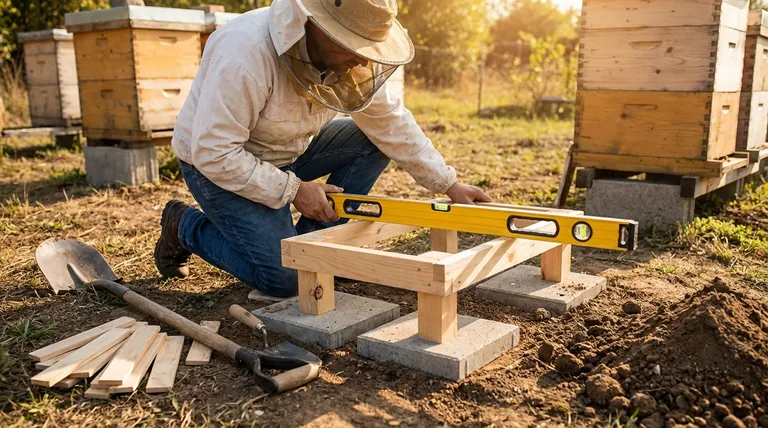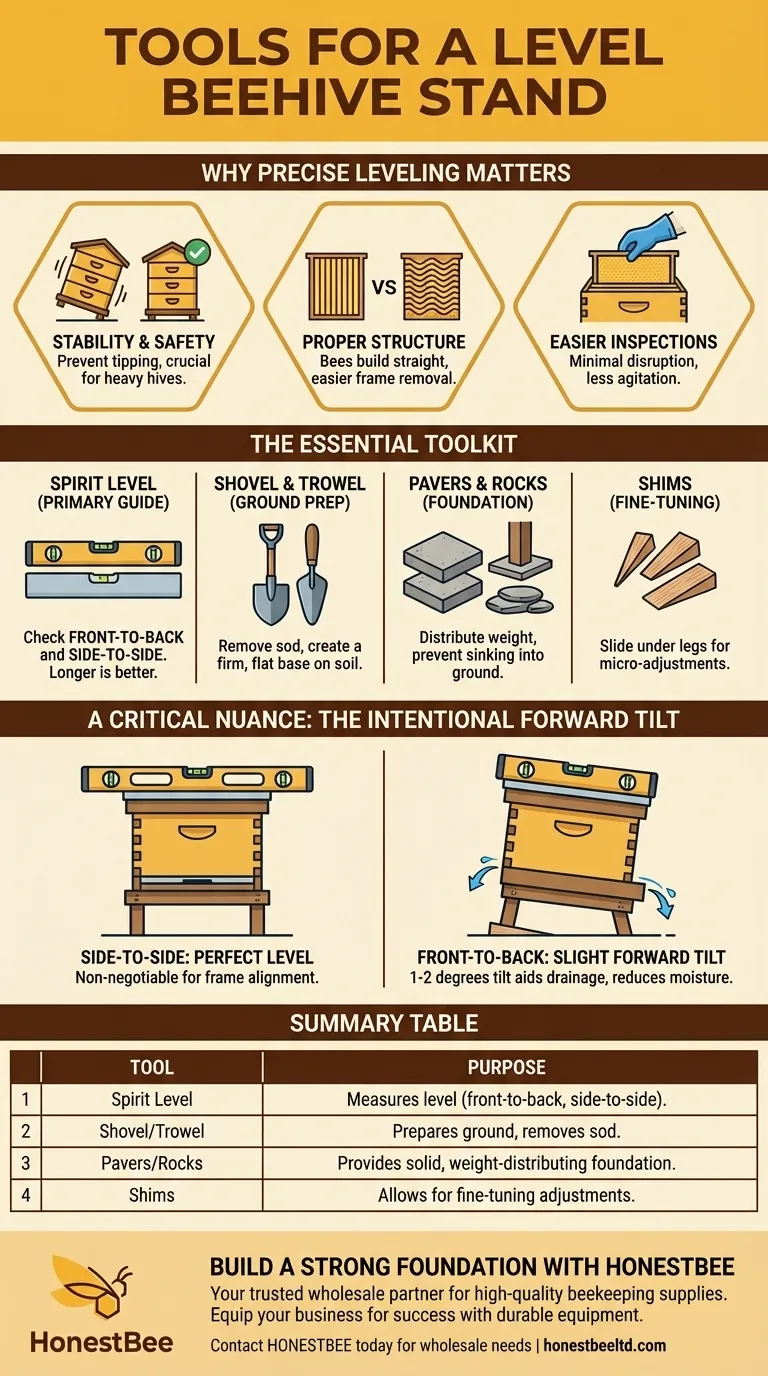To properly level a beehive stand, the essential tool is a spirit level, often called a carpenter's or bubble level. However, the level only tells you if the stand is straight; you will also need tools to adjust the ground beneath it. This typically includes a shovel or garden trowel for digging and sturdy materials like concrete pavers, flat rocks, or shims for foundational support and fine-tuning.
Your goal is not just to make the stand level, but to create a stable, long-term foundation. Proper site preparation and leveling are fundamental investments in the hive's stability, the colony's health, and your own safety during inspections.

Why Precise Leveling is Non-Negotiable
A beehive is a heavy, top-heavy structure that can easily weigh over 100 pounds (45 kg) when full of honey and bees. Placing it on an unstable or unlevel base is a significant risk.
Ensuring Hive Stability and Safety
The most immediate reason for leveling is to prevent the hive from tipping over. A slight lean can become a major problem when the ground becomes soft and saturated from rain.
A toppled hive is disastrous for the colony and can be dangerous for anyone nearby. A stable base is your first line of defense against accidents.
Promoting Proper Hive Structure
Bees build their comb straight down, guided by gravity. If the hive is tilted, they may build wavy comb or attach it across multiple frames.
This "cross comb" makes hive inspections incredibly difficult. Pulling out a single frame can tear up the comb, destroy brood, and spill honey, which agitates the colony and can trigger robbing from other bees.
Easing Hive Inspections and Maintenance
When a hive is level, the frames hang perfectly parallel with equal spacing between them. This allows you to remove and inspect each frame with minimal disruption to the bees and the surrounding comb.
The Essential Toolkit for a Level Hive
Achieving a stable foundation requires more than just one tool. Your toolkit should include items for measuring, digging, and supporting.
The Spirit Level: Your Primary Guide
A carpenter's spirit level is your most critical tool. A longer level (24 inches or more) will give you a more accurate reading across the entire stand.
You must check for level in two directions: front-to-back and side-to-side. Both must be accurate to ensure true stability.
Shovel and Trowel: For Ground Preparation
Never place a hive stand directly on top of grass or uneven soil. The vegetation will decompose and the soil will settle unevenly.
Use a shovel to remove the sod and topsoil in an area slightly larger than the stand's footprint. This creates a firm base to build upon.
Pavers and Shims: For Foundation and Fine-Tuning
Concrete pavers or flat fieldstones provide the best foundation. They distribute the weight of the hive and prevent the stand's legs from sinking into the ground.
Shims (thin, tapered pieces of wood or plastic) are used for micro-adjustments. If one leg is slightly low after placing the stand on your pavers, you can slide a shim underneath it to achieve a perfect level.
A Critical Nuance: The Intentional Forward Tilt
While a hive must be perfectly level from side-to-side, many experienced beekeepers introduce a very slight forward tilt.
The Purpose of a Forward Tilt
A slight downward slope from the back of the hive to the front entrance helps with drainage. It ensures any rainwater that blows into the entrance or condensation that forms inside runs out of the hive instead of pooling on the bottom board.
This simple adjustment helps prevent wood rot and reduces excess moisture, which contributes to a healthier colony environment.
How to Achieve the Tilt
First, focus on making the stand perfectly level from side-to-side. This is non-negotiable for frame alignment.
Once the side-to-side is perfect, adjust the back legs so they are slightly higher than the front legs. The bubble in your level should be just off-center. A tilt of 1-2 degrees is all that is needed.
Making the Right Choice for Your Goal
Leveling a hive stand is a foundational task that pays dividends for the entire life of the colony. Your specific approach depends on your primary concern.
- If your primary focus is maximum stability: Use solid concrete pavers or a single concrete slab as a base to prevent any sinking into the soil over time.
- If your primary focus is hive health and drainage: Ensure the stand is perfectly level side-to-side, then introduce a slight forward tilt to help rainwater drain away from the entrance.
- If your primary focus is ease of maintenance: A perfectly level hive (side-to-side) will ensure frames hang correctly, making your inspections smoother and less disruptive to the bees.
A few minutes spent with a level and a shovel provides a stable and secure home for your bees, setting the stage for a thriving colony.
Summary Table:
| Tool | Purpose |
|---|---|
| Spirit Level | Measures if the stand is level front-to-back and side-to-side. |
| Shovel/Trowel | Prepares the ground by removing sod and creating a firm base. |
| Pavers/Rocks | Provides a solid foundation to distribute weight and prevent sinking. |
| Shims | Allows for fine-tuning and micro-adjustments to achieve perfect level. |
Build a Strong Foundation for Your Apiary with HONESTBEE
Proper hive leveling is the first step to a productive and safe apiary. For commercial beekeepers and equipment distributors, having access to durable, reliable supplies is just as critical. HONESTBEE is your trusted wholesale partner, supplying the high-quality beekeeping supplies and equipment you need to build a thriving operation.
We provide the tools that support your success, from hive stands to protective gear. Let us help you equip your business for maximum efficiency and colony health.
Contact HONESTBEE today to discuss your wholesale supply needs and get a quote.
Visual Guide

Related Products
- Professional Engraved Round Hive Number Tags for Beekeeping
- Plastic Bee Hive Stand for Beekeeping
- Professional Ant-Proof Beehive Stand with Integrated Moat for Beekeeping
- Wholesales Dadant Size Wooden Bee Hives for Beekeeping
- Professional Galvanized Hive Strap with Secure Locking Buckle for Beekeeping
People Also Ask
- What are the characteristics of Posca pens for marking queens? A Safe, Durable Solution for Hive Management
- What is the best height for a hive stand? Optimize for Pest Control and Beekeeper Ergonomics
- What is the purpose of a hive stand, and why is it beneficial? Elevate Your Hive for Colony Health and Beekeeper Comfort
- What maintenance is required for hive straps? A Guide to Cam Buckle vs. Ratchet Strap Care
- Why are Posca pens commonly used for marking queen bees? The Safest, Most Durable Method for Beekeepers



















